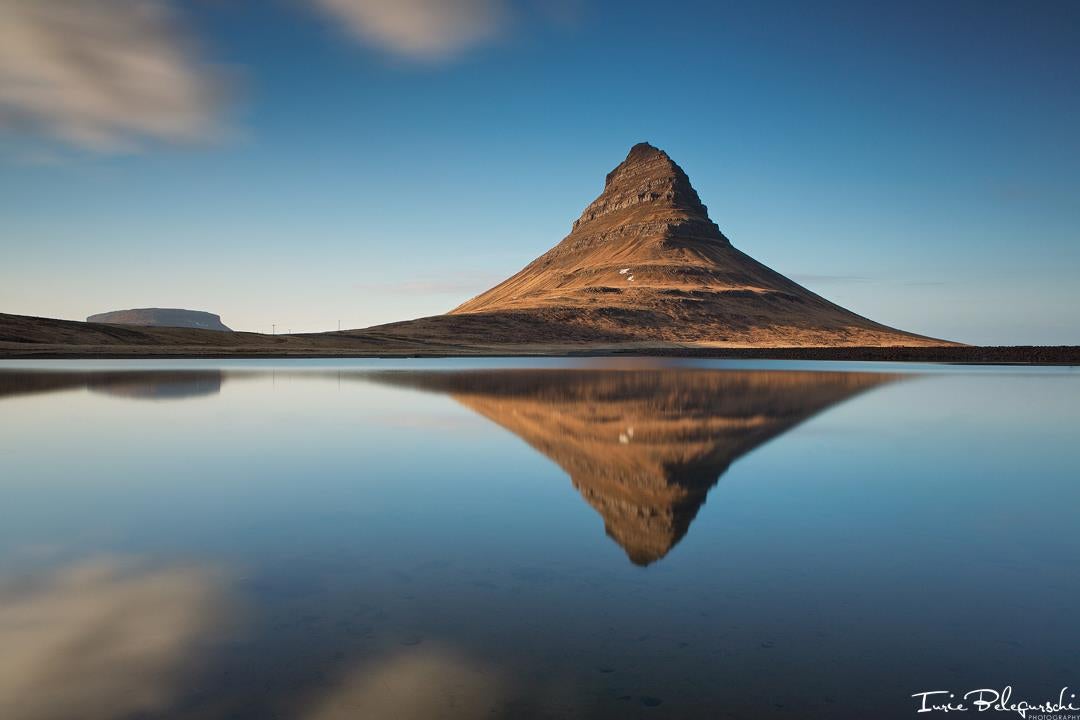
Tucked along Iceland’s far eastern coastline, the Eastfjords are among the country’s most underrated regions. It’s where majestic mountains plunge into narrow fjords, reindeer graze in the wild, and colorful fishing villages hug the peaceful shore.
Unlike the bustling South Coast or the Golden Circle, East Iceland offers a peaceful, scenic experience with fewer crowds. It’s ideal for those seeking natural beauty, rich folklore, and immersive outdoor adventures through guided Eastfjord tours.
Why You Can Trust Our Content
Guide to Iceland is the most trusted travel platform in Iceland, helping millions of visitors each year. All our content is written and reviewed by local experts who are deeply familiar with Iceland. You can count on us for accurate, up-to-date, and trustworthy travel advice.
For more flexibility, you can choose from the large selection of rental cars in Iceland and embark on your own adventure. When planning your trip, be sure to explore the wide range of accommodations, where cozy guesthouses and scenic hotels offer the perfect rest after a day of exploring the best places to visit in East Iceland.
If you're seeking authentic Icelandic culture, off-the-beaten-path attractions, and unforgettable views, this ultimate guide to the Eastfjords of Iceland is for you.
Why Visit Iceland’s Eastfjords?
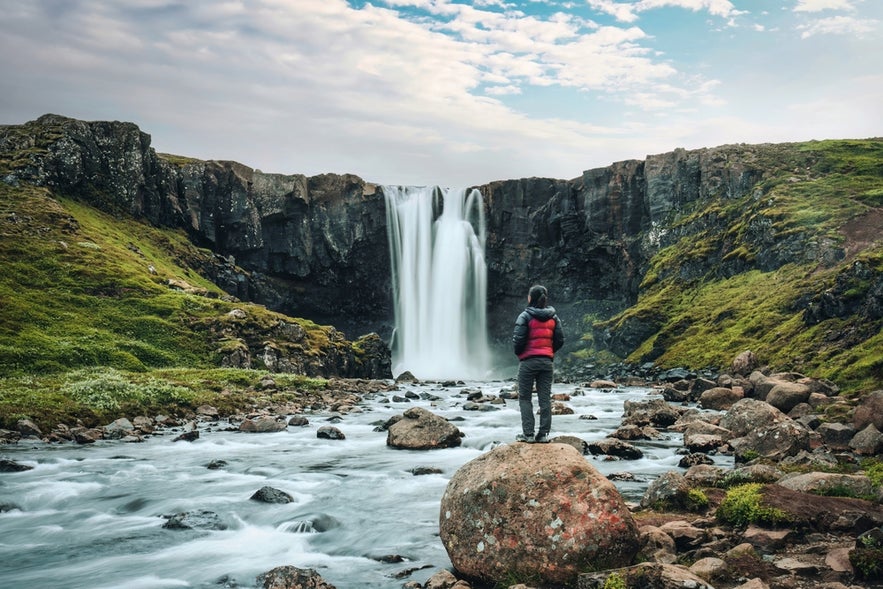 The Eastfjords are perfect for travelers seeking quiet beauty, local culture, and unforgettable natural landscapes. Stretching from Berufjordur to Borgarfjordur Eystri, this region features jagged peaks, black-sand beaches, ancient lava fields, and misty fjords. Coastal roads wind through remote fishing villages, offering some of the most scenic drives in Iceland.
The Eastfjords are perfect for travelers seeking quiet beauty, local culture, and unforgettable natural landscapes. Stretching from Berufjordur to Borgarfjordur Eystri, this region features jagged peaks, black-sand beaches, ancient lava fields, and misty fjords. Coastal roads wind through remote fishing villages, offering some of the most scenic drives in Iceland.
Charming towns to visit in Iceland’s Eastfjords include Djupivogur, Seydisfjordur, and Breiddalsvik, each with its own character and coastal charm. You’ll also find cozy cafes and some of the top restaurants in East Iceland, where locally caught fish and homegrown ingredients take center stage. It’s a haven for hikers, foodies, and slow-travel explorers alike.
Best Time To Visit the Eastfjords
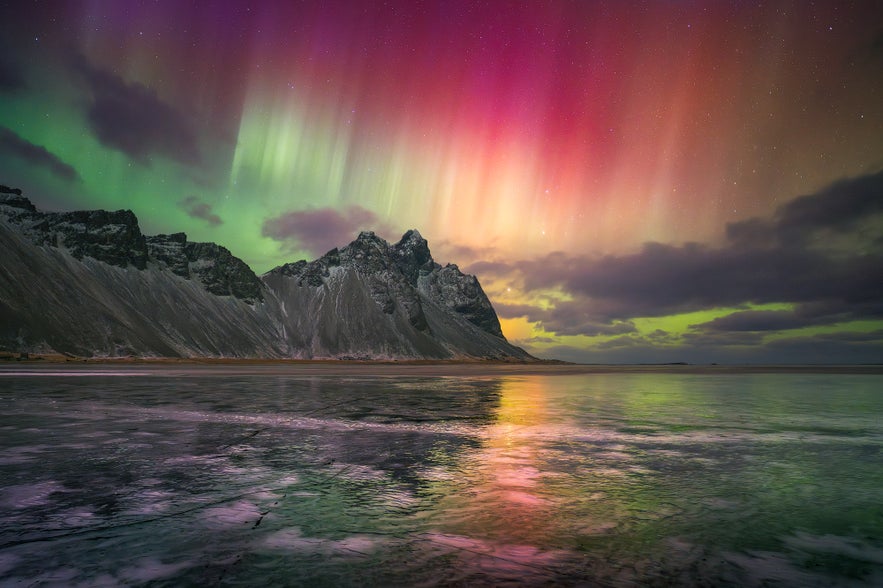 The Eastfjords are stunning year-round, but each season offers a uniquely different experience. Whether you're chasing the northern lights, hiking to waterfalls under the midnight sun, or enjoying quiet drives through dramatic fjords, knowing when to go will help you make the most of your journey.
The Eastfjords are stunning year-round, but each season offers a uniquely different experience. Whether you're chasing the northern lights, hiking to waterfalls under the midnight sun, or enjoying quiet drives through dramatic fjords, knowing when to go will help you make the most of your journey.
Here’s a detailed look at what to expect in East Iceland during each season:
Spring in the Eastfjords
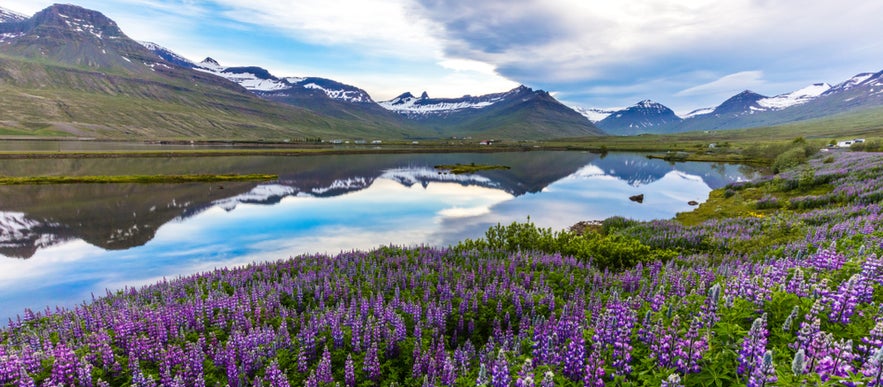 Spring (March to May) brings a quiet beauty to East Iceland. Snow begins to melt, waterfalls swell with fresh runoff, and birdwatching opportunities increase as migratory species return.
Spring (March to May) brings a quiet beauty to East Iceland. Snow begins to melt, waterfalls swell with fresh runoff, and birdwatching opportunities increase as migratory species return.
Most notably, puffins begin nesting again in late April and May. For the best sightings, join one of the many birdwatching tours in Iceland focused on East Iceland’s diverse birdlife.
During spring in Iceland, the landscape transitions from icy white to soft greens and blooming mosses, offering peaceful, low-tourism travel with fresh air and crisp light. It's also a great time for photography, with dramatic contrasts between lingering snowcaps and budding earth.
Some higher elevation hikes may still have snow cover, so plan accordingly. Guesthouses and hotels often offer better availability and prices during this shoulder season.
Summer in the Eastfjords
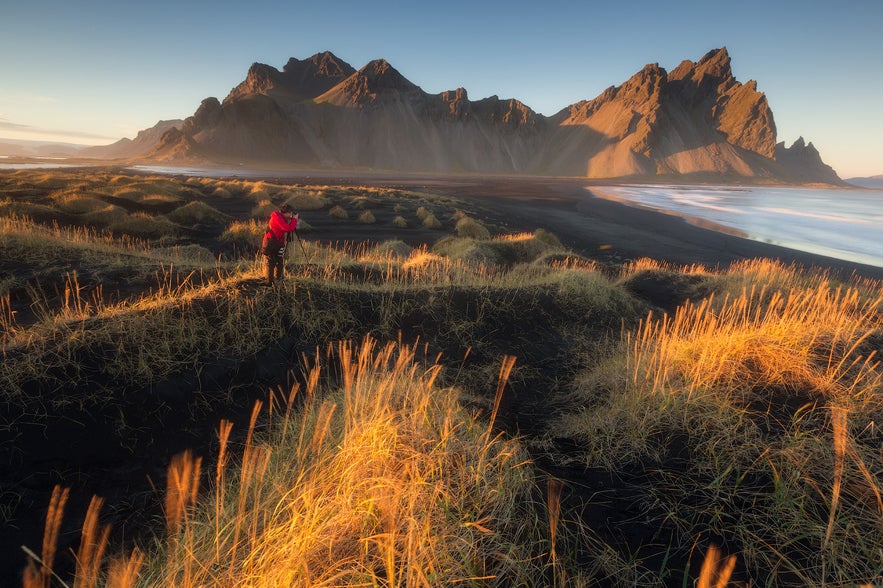 Summer (June to August) is the most popular time to explore the Eastfjords, especially with summer self-drive tours, and for good reason. With nearly 24 hours of daylight, there is plenty of time for scenic drives, remote hikes, and golden-hour photography at any hour of the day or night.
Summer (June to August) is the most popular time to explore the Eastfjords, especially with summer self-drive tours, and for good reason. With nearly 24 hours of daylight, there is plenty of time for scenic drives, remote hikes, and golden-hour photography at any hour of the day or night.
Wildlife is especially active in summer. Puffins nest in cliffside colonies like Hafnarholmi in Borgarfjordur Eystri, and reindeer roam the Highlands. This makes summer the best season for wildlife tours in Iceland, especially in East Iceland, offering opportunities to see seals, seabirds, and even whales along the coast.
Summer in Iceland also brings energy to Eastfjord’s villages. Coastal communities come alive with local festivals, including Braedslan, one of Iceland’s most beloved small-town music events.
For a truly unique adventure, try midnight sun horse riding in East Iceland from Egilsstadir. Riding through glowing landscapes under the never-setting sun is an unforgettable way to experience the region. With all roads and trails fully open in summer, this is the ideal season to visit the Eastfjords.
Autumn in the Eastfjords
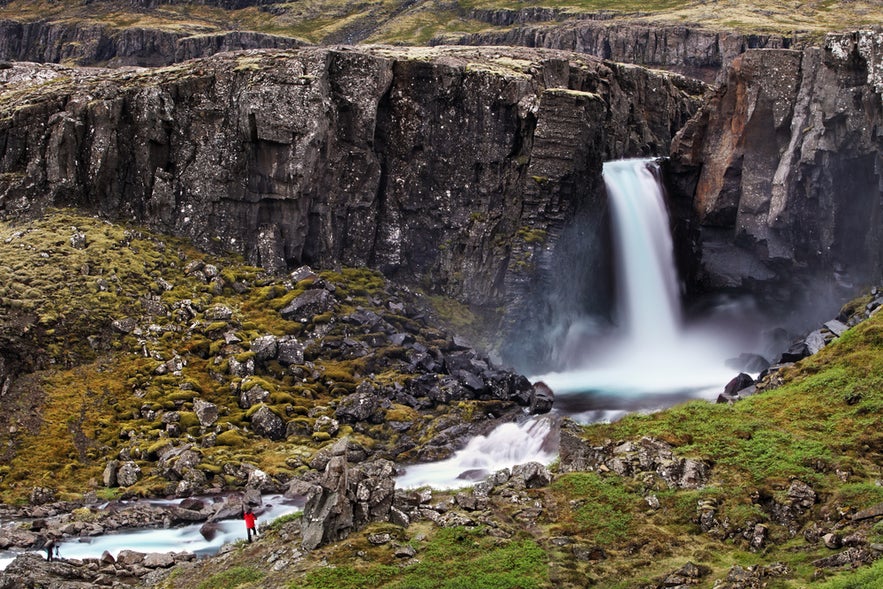 Autumn (September to November) is one of the most underrated times to visit the Eastfjords. Cooler temperatures are balanced by rich golden landscapes and reduced tourist traffic. It’s a spectacular time for landscape photography, with gold and red hues blanketing the mountainsides and mist rising from still fjords.
Autumn (September to November) is one of the most underrated times to visit the Eastfjords. Cooler temperatures are balanced by rich golden landscapes and reduced tourist traffic. It’s a spectacular time for landscape photography, with gold and red hues blanketing the mountainsides and mist rising from still fjords.
Iceland in autumn also sees the start of the northern lights season. From mid-September onward, long, dark nights return, giving you a chance to witness auroras over quiet villages and unlit mountain passes.
While some services begin to close for the season, many guided experiences continue to run well into October, including wildlife and photography excursions.
Winter in the Eastfjords
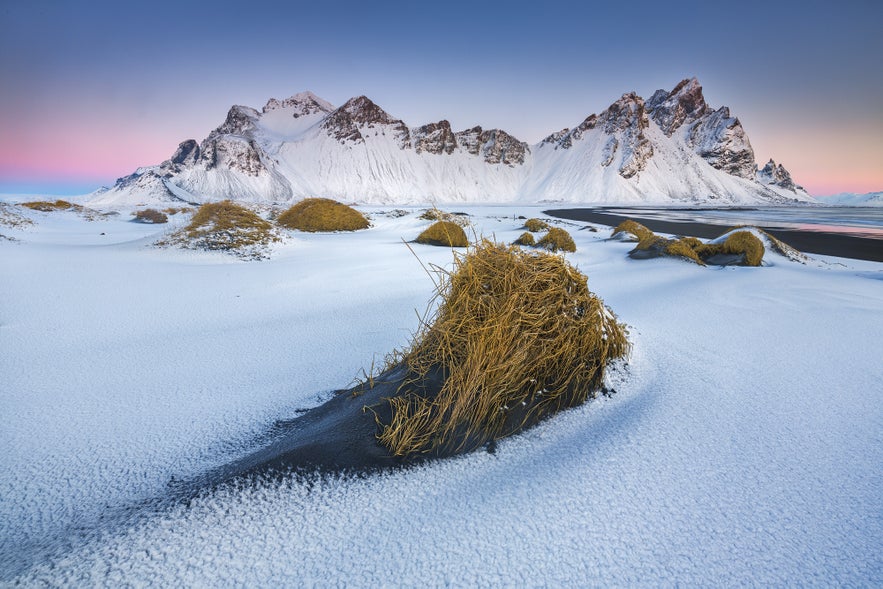 Visiting the Eastfjords in winter (December to February) is a magical experience for those who don’t mind isolation and adventure. Snow transforms the region into a surreal white landscape, ideal for frozen waterfall photography, tranquil drives, and, of course, northern lights hunting.
Visiting the Eastfjords in winter (December to February) is a magical experience for those who don’t mind isolation and adventure. Snow transforms the region into a surreal white landscape, ideal for frozen waterfall photography, tranquil drives, and, of course, northern lights hunting.
However, travel requires preparation: Renting 4WD vehicles is essential, as some roads may be icy or closed due to weather. That said, for those with the right equipment and flexibility, Iceland in winter offers unique solitude and unforgettable snowy landscapes.
With minimal light pollution and wide open skies, the Eastfjords are also an excellent place to witness the northern lights in all their glory.
It’s also a great time to unwind in geothermal pools in towns like Eskifjordur or Reydarfjordur, surrounded by frost-covered mountains.
Top Places To Visit in the Eastfjords

Seydisfjordur
Cradled by misty mountains and lapped by calm fjord waters, Seydisfjordur is one of Iceland’s most picturesque villages. Known for its colorful wooden houses and thriving arts scene, this Eastfjords gem feels like stepping into a Nordic fairytale. It is also the arrival point for the ferry from Denmark, so for some visitors, it’s their first introduction to Iceland.
There are countless things to do in Seydisfjordur, from browsing quirky art shops to hiking up to cascading waterfalls like Gufufoss. The rainbow-painted street leading to the iconic Seydisfjardarkirkja Blue Church is a must-see and a favorite photo spot.
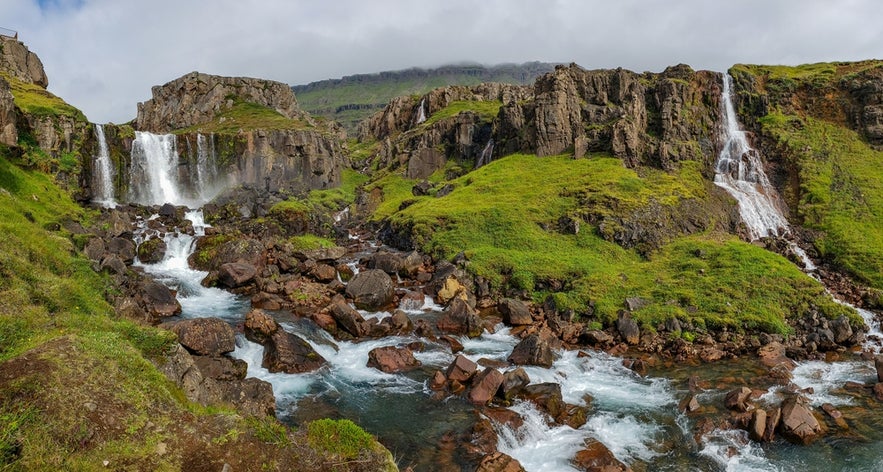 For visitors arriving by cruise, Seydisfjordur shore excursions offer a perfect mix of culture, nature, and discovery.
For visitors arriving by cruise, Seydisfjordur shore excursions offer a perfect mix of culture, nature, and discovery.
One standout experience is the geothermal bathing and canyon shore excursion in East Iceland from Seydisfjordur. This tour lets you relax in naturally heated pools while surrounded by stunning canyon landscapes. It’s a peaceful, unforgettable way to soak in the raw beauty of the Eastfjords.
Studlagil Canyon
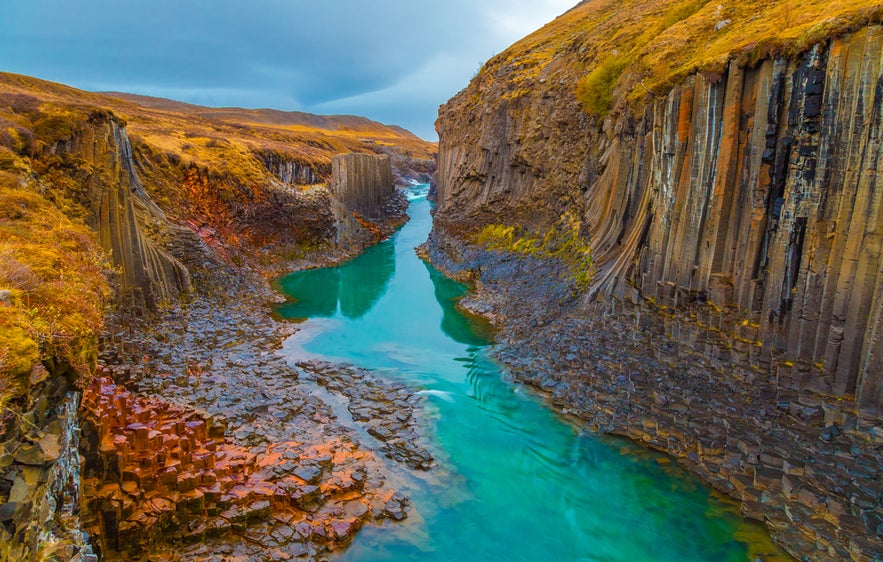 Tucked away in the heart of East Iceland, Studlagil Canyon is one of the country’s most striking natural wonders. Its sheer basalt columns line a turquoise glacial river, creating a surreal, otherworldly landscape. Once hidden beneath the Jokla River, this canyon only became accessible after a hydroelectric project lowered the water levels.
Tucked away in the heart of East Iceland, Studlagil Canyon is one of the country’s most striking natural wonders. Its sheer basalt columns line a turquoise glacial river, creating a surreal, otherworldly landscape. Once hidden beneath the Jokla River, this canyon only became accessible after a hydroelectric project lowered the water levels.
Adventurers and photographers flock here for dramatic viewpoints and scenic hikes along the canyon rim. The hidden gems of Studlagil Canyon shore excursion from Seydisfjordur Port offers an immersive experience, guiding you through lesser-known trails and panoramic lookout spots. It's an ideal trip for nature lovers seeking East Iceland's raw, untouched beauty.
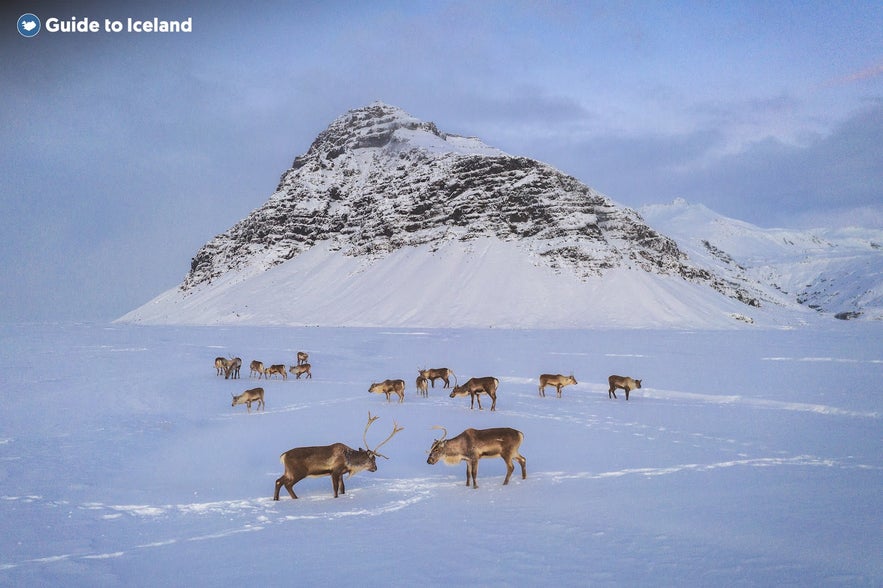
Hengifoss Waterfall
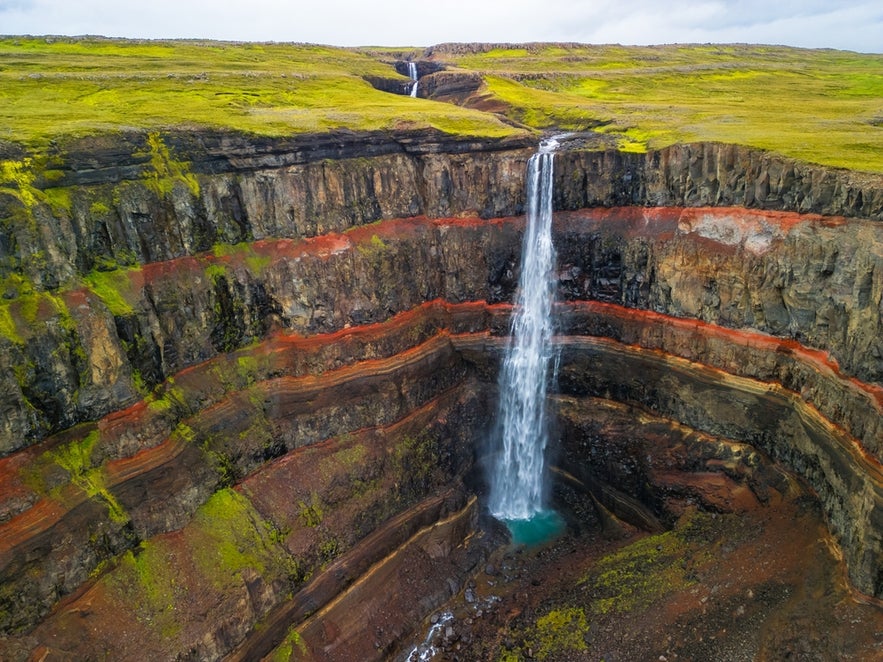 Standing at 420 feet (128 meters), Hengifoss is one of Iceland’s tallest and most visually striking waterfalls. Layers of red clay and dark basalt create a stunning striped cliff face, revealing a dramatic history of volcanic eruptions and geological change. Its bold colors and towering height make it a favorite for photographers and nature lovers alike.
Standing at 420 feet (128 meters), Hengifoss is one of Iceland’s tallest and most visually striking waterfalls. Layers of red clay and dark basalt create a stunning striped cliff face, revealing a dramatic history of volcanic eruptions and geological change. Its bold colors and towering height make it a favorite for photographers and nature lovers alike.
The hike to Hengifoss takes about one hour each way, covering roughly 1.5 miles (2.5 kilometers) of moderately steep terrain. Along the trail, you'll encounter Litlanesfoss, a smaller yet impressive waterfall surrounded by tall basalt columns. This unique combination of waterfalls makes the journey as rewarding as the destination. Don't forget your camera and sturdy hiking shoes.
Borgarfjordur Eystri
 Borgarfjordur Eystri is a remote village wrapped in fjords and folklore. It’s famous for its puffin colony at Hafnarholmi, where thousands of birds nest on grassy cliffs just steps from wooden viewing platforms. The small group puffin tour of Borgarfjordur Eystri lets you experience these charismatic creatures up close, without the crowds.
Borgarfjordur Eystri is a remote village wrapped in fjords and folklore. It’s famous for its puffin colony at Hafnarholmi, where thousands of birds nest on grassy cliffs just steps from wooden viewing platforms. The small group puffin tour of Borgarfjordur Eystri lets you experience these charismatic creatures up close, without the crowds.
Beyond puffins, this village is steeped in Icelandic legends and elf folklore. It is said to be home to Alfaborg, the “Elf Queen’s Castle,” a rocky hill believed to be a sacred elf dwelling. Hikers can explore trails like Viknaslodir (the “Trails of the Inlets”), a network of remote routes that pass abandoned farms, dramatic cliffs, and supposed elf settlements.
The peaceful charm, dramatic coastlines, and surreal sense of magic make Borgarfjordur Eystri a highlight of the Eastfjords. It’s a place where puffins and legends live side by side.
Hallormsstadaskogur and Lake Lagarflot
 Tucked along the winding shores of Lake Lagarfljot in the Eastfjords, Hallormsstadaskogur is Iceland’s largest national forest—and a rare oasis of woodland in a land shaped by fire and ice. The forest stretches around much of the lake, offering quiet trails beneath towering trees and tranquil views across the water.
Tucked along the winding shores of Lake Lagarfljot in the Eastfjords, Hallormsstadaskogur is Iceland’s largest national forest—and a rare oasis of woodland in a land shaped by fire and ice. The forest stretches around much of the lake, offering quiet trails beneath towering trees and tranquil views across the water.
With over 80 tree species, from native birch to imported evergreens, this peaceful retreat invites visitors to explore well-marked paths ranging from gentle lakeside strolls to panoramic hikes. Wildlife is part of the charm too, as you might spot reindeer, arctic foxes, or rare bird species.
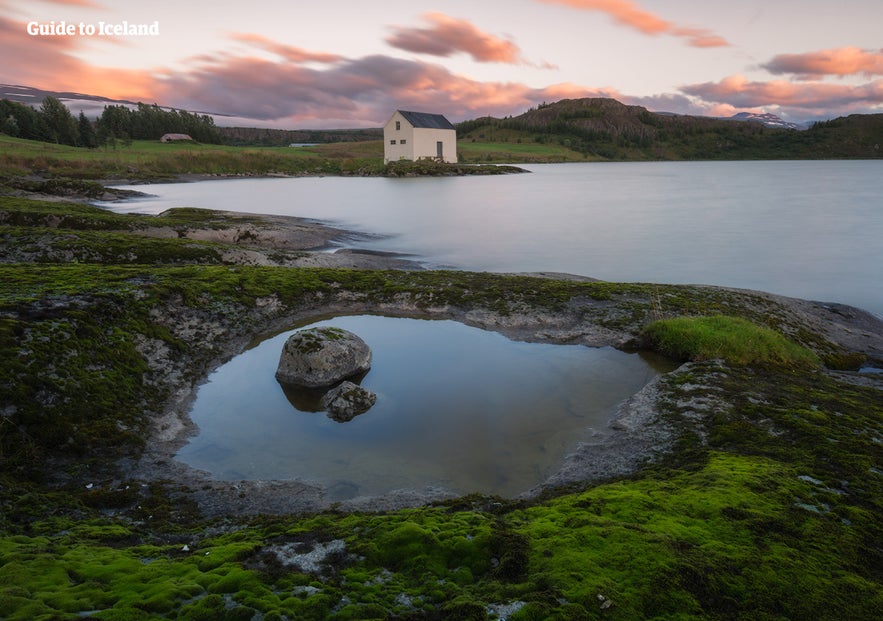 And don’t forget to keep an eye on the lake: local legend says it’s home to the mysterious Lagarfljot Wyrm, Iceland’s own version of the Loch Ness Monster.
And don’t forget to keep an eye on the lake: local legend says it’s home to the mysterious Lagarfljot Wyrm, Iceland’s own version of the Loch Ness Monster.
Hallormsstadaskogur is the perfect place to unwind while exploring the Eastfjords. It’s ideal for picnics and leisurely walks.
If you’re planning on camping in Iceland, Hallormsstadarskogur is also home to some of East Iceland’s most scenic campsites. Whether you're traveling with camping equipment or renting a campervan, the forest offers a peaceful, well-equipped spot to spend the night surrounded by nature.
Petra’s Stone Collection
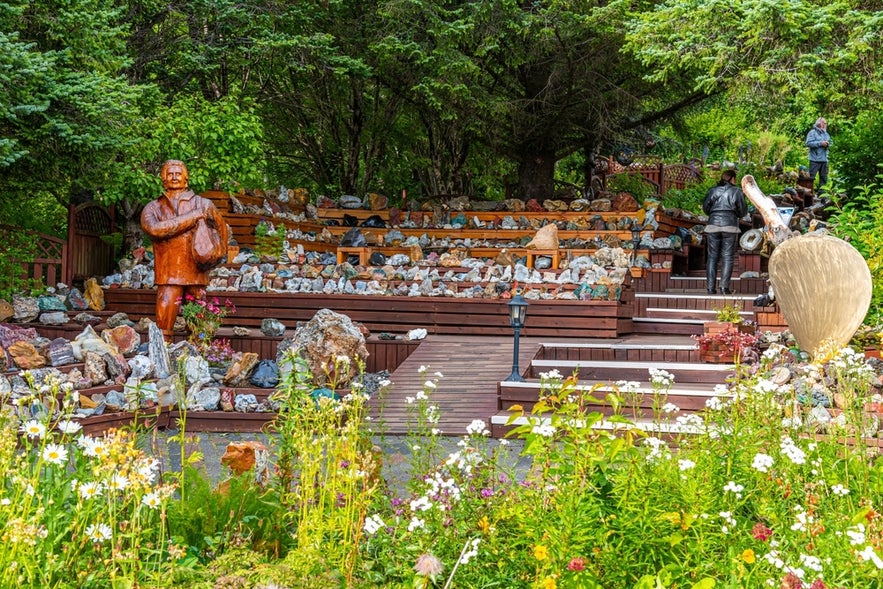 Located in the quiet village of Stodvarfjordur, Petra’s Stone Collection is one of Eastfjords’ most unique attractions. This colorful museum features thousands of stones, minerals, and crystals, all lovingly collected by local resident Ljosbjorg Petra Maria throughout her life. What began as a personal passion became a national treasure.
Located in the quiet village of Stodvarfjordur, Petra’s Stone Collection is one of Eastfjords’ most unique attractions. This colorful museum features thousands of stones, minerals, and crystals, all lovingly collected by local resident Ljosbjorg Petra Maria throughout her life. What began as a personal passion became a national treasure.
The collection includes everything from sparkling quartz to rare volcanic gems, many found right in East Iceland. Each room and garden is thoughtfully arranged, giving visitors a hands-on feel for the region’s rich geological history. Even those with little interest in rocks often leave fascinated and inspired.
Petra’s Stone Collection offers a heartfelt glimpse into Eastfords’ life and one woman’s deep love for nature. Surrounded by mountains and coastal charm, it is a meaningful and memorable stop along Iceland’s scenic eastern coast.
Breiddalsvik & Breiddalur Valley
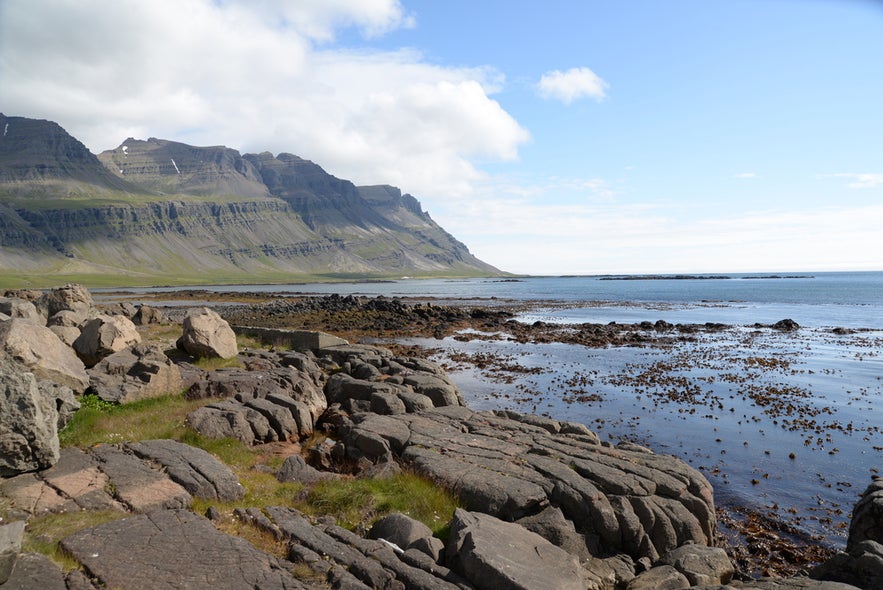 Breiddalsvik is a peaceful village with wide, open coastal views. It’s an ideal base for exploring the Eastfjords at a slower pace. The harbor, local museum, and surrounding nature offer simple but rewarding experiences far from crowded tourist routes.
Breiddalsvik is a peaceful village with wide, open coastal views. It’s an ideal base for exploring the Eastfjords at a slower pace. The harbor, local museum, and surrounding nature offer simple but rewarding experiences far from crowded tourist routes.
Just beyond the village, Fossarfoss Waterfall flows through a forested ravine, reached by an easy trail lined with native birch trees. Deeper in the Breiddalur Valley, remote waterfalls like Flogufoss and Beljandi await hikers on narrow trails and shallow river crossings. These hidden gems offer serene walks and stunning views.
For a mindful outdoor experience, try the yoga hiking tour in Eastfjords from Breiddalsvik, combining gentle trekking with guided meditation in nature. Adventurers can also explore the rugged Streiti Coastline Super Jeep tour in East Iceland from Breiddalsvik. This coastal journey reveals lava cliffs, crashing waves, and sea stacks few travelers ever reach.
Whether you seek tranquility or excitement, Breiddalsvik is a quiet gateway to East Iceland’s untamed beauty.
Best Things To Do in the Eastfjords
The Eastfjords offer a quieter, wilder escape from the country’s more traveled paths. From dramatic fjords and colorful fishing villages to puffin colonies and hidden geothermal baths, this untouched part of Iceland is full of authentic experiences. Here are the top things to see and do in the Eastfjords that will make your journey unforgettable.
Scenic Driving Along the Eastfjords
 The Eastfjords offer some of Iceland’s most breathtaking coastal drives. Winding roads like Route 92, Route 96, and sections of the Ring Road reveal steep mountains, secluded coves, and mirror-like fjords. Each turn offers new views and hidden gems that most travelers miss.
The Eastfjords offer some of Iceland’s most breathtaking coastal drives. Winding roads like Route 92, Route 96, and sections of the Ring Road reveal steep mountains, secluded coves, and mirror-like fjords. Each turn offers new views and hidden gems that most travelers miss.
Driving these routes is a highlight of many self-drive tours in Iceland, especially for those seeking quieter, less-traveled regions. You’ll pass through charming fishing villages like Faskrudsfjordur and Djupivogur, with opportunities to stop for fresh seafood and local crafts.
To experience the quieter side of Iceland, these are the top-rated self-drive tours that make it easy to experience some of the hidden beauty of the region:
-
10-day self-drive tour of the complete Ring Road of Iceland: This top-rated package includes stunning drives through the Eastfjords with plenty of time to see the wonders of the Ring Road and Snaefellsnes Peninsula.
-
1-week summer self-drive tour of the Ring Road of Iceland: If you're on a tighter schedule, this highly rated summer self-drive makes it easy to see the Ring Road highlights, including the Eastfjords.
-
10-Day Northern Lights Self-Drive Tour of the Ring Road of Iceland: This popular 10-day winter self-drive tour takes you along the iconic Ring Road of Iceland, offering breathtaking landscapes, frozen waterfalls, and plenty of time to explore highlights like the Golden Circle, South Coast, and Vatnajokull National Park.
Hiking Eastfjords Trails
 The Eastfjords are home to some of the best hiking trails in Iceland, where fjords meet rugged mountains and peaceful valleys. One must-see hike is the Hengifoss Waterfall trail, which rewards hikers with Iceland’s third-tallest waterfall and striking basalt columns.
The Eastfjords are home to some of the best hiking trails in Iceland, where fjords meet rugged mountains and peaceful valleys. One must-see hike is the Hengifoss Waterfall trail, which rewards hikers with Iceland’s third-tallest waterfall and striking basalt columns.
The Breiddalur Valley offers gentle terrain surrounded by vibrant wildflowers and dramatic cliffs. According to the Breiddalsvik trail map, trails here range from easy strolls to moderate hikes, perfect for all levels. Nearby, the enchanting elf-lore hiking paths in Borgarfjordur Eystri combine natural beauty with Icelandic folklore.
Other notable natural highlights include:
-
Storurd Boulders is a hidden valley filled with giant moss-covered boulders, turquoise ponds, and dramatic mountain views, reached by a scenic hiking trail.
-
Teigarhorn Natural Monument: a geological treasure with fossil sites and birdwatching opportunities.
-
Nykurhylur Pool: a hidden geothermal pool ideal for a soothing post-hike dip.
-
Vattarnes Peninsula trail: a coastal path famed for panoramic ocean views and puffin colonies.
Whether you're joining hiking tours in Iceland or venturing out on your own, the Eastfjords provide an authentic Icelandic hiking experience filled with unique landscapes and tranquil escapes.
Puffin & Wildlife Watching in the Eastfjords
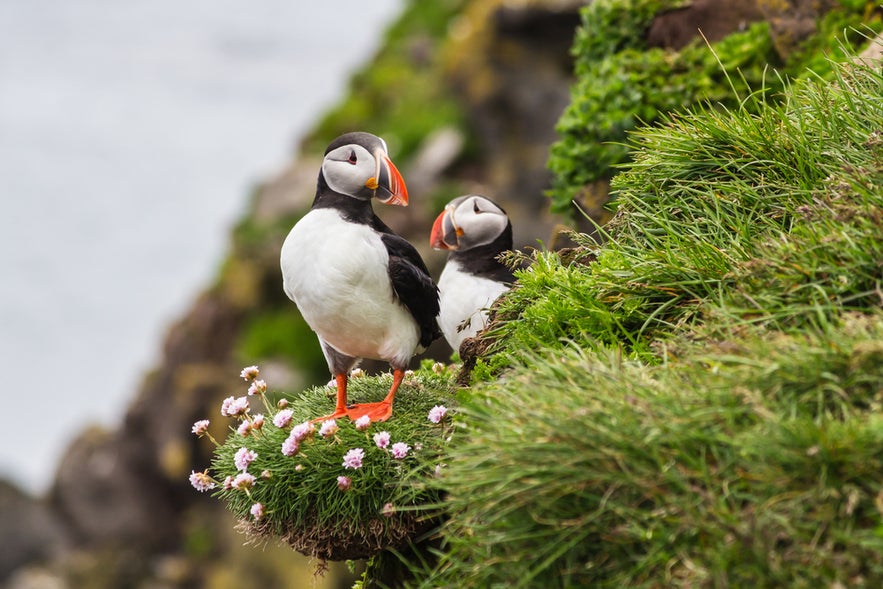 The Eastfjords are one of Iceland’s top regions for wildlife encounters, home to wild reindeer, seabirds, and rare marine life. Wild reindeer roam freely across grassy slopes and valleys, especially in spring and early summer.
The Eastfjords are one of Iceland’s top regions for wildlife encounters, home to wild reindeer, seabirds, and rare marine life. Wild reindeer roam freely across grassy slopes and valleys, especially in spring and early summer.
Birdwatchers will love Hallormsstadaskogur Forest, where songbirds and small mammals live among Iceland’s largest woodland. Coastal cliffs and fjords attract seabirds, with puffins nesting in huge numbers at Hafnarholmi Puffin Colony. Wooden walkways bring you within feet of these curious birds—no steep hikes needed.
To get even closer, book the 1-hour private RIB puffin tour in East Iceland, a fast and scenic boat trip. For a slower pace, the puffin watching shore excursion in Borgarfjordur Eystri with Seydisfjordur Port transfer offers relaxed access to prime puffin-viewing sites. With few crowds and rich biodiversity, the Eastfjords are a must for wildlife lovers and photographers.
Relaxing in Geothermal Pools
The Eastfjords offer a peaceful alternative to Iceland’s busier hot springs, with small-town pools set against dramatic mountain backdrops. In Eskifjordur and Reydarfjordur, you’ll find geothermal swimming pools where locals gather to unwind in warm, mineral-rich waters after a day outdoors.
A must-visit spot is Vok Baths, located just outside Egilsstadir, one of the best geothermal pools in Iceland. Surrounded by Lake Urridavatn, its floating infinity pools offer a serene and stylish soak. The Vok Baths admission gives access to hot and cold pools, steam rooms, and lake dips, perfect for relaxation and rejuvenation.
For a wilder experience, visit Djupavogskorin Hot Spring near Djupivogur, a simple, open-air pool with stunning sea views. Don’t miss the charming Laugavallalaug Hot Spring nestled near a picturesque waterfall, offering another peaceful spot to soak in East Iceland’s serene landscape.
Photography & Northern Lights in the Eastfjords
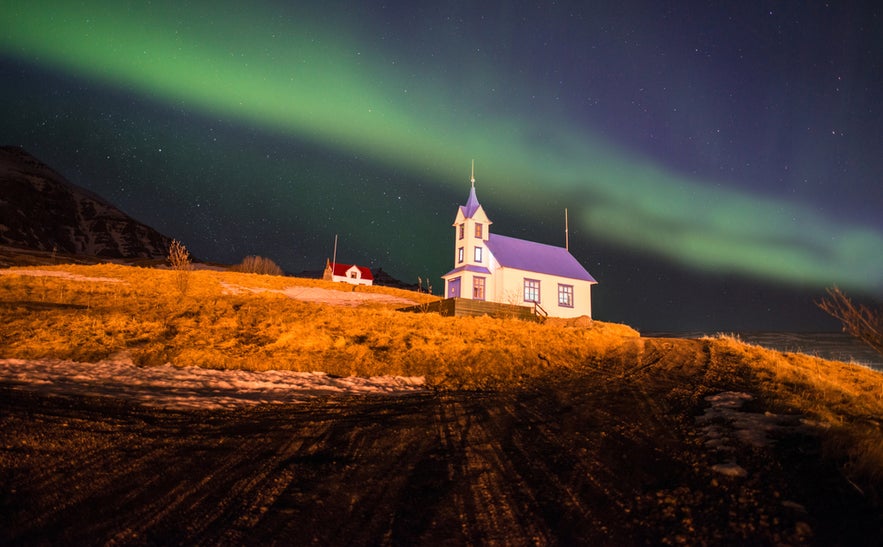 The Eastfjords are a dream destination for photographers, offering dramatic fjords, jagged peaks, quiet harbors, and untouched wilderness. Sunrise and sunset paint the skies over towns like Seydisfjordur, Djupivogur, and Borgarfjordur Eystri, perfect for capturing Iceland’s raw, rugged beauty.
The Eastfjords are a dream destination for photographers, offering dramatic fjords, jagged peaks, quiet harbors, and untouched wilderness. Sunrise and sunset paint the skies over towns like Seydisfjordur, Djupivogur, and Borgarfjordur Eystri, perfect for capturing Iceland’s raw, rugged beauty.
In winter, this region becomes one of the best places to see the northern lights in Iceland, thanks to minimal light pollution and wide, open skies. Top aurora hunting spots include Vattarnes Peninsula, Egilsstadir, and the dark valleys around Faskrudsfjordur. Clear nights often reveal stunning displays of green and purple light.
Whether you’re a pro or a beginner, consider joining guided photography tours in Iceland focused on East Iceland’s natural wonders. With fewer crowds and dramatic backdrops, the Eastfjords offer unforgettable photography opportunities, from long-exposure aurora shots to serene fjord reflections at dawn.
Where To Stay in the Eastfjords
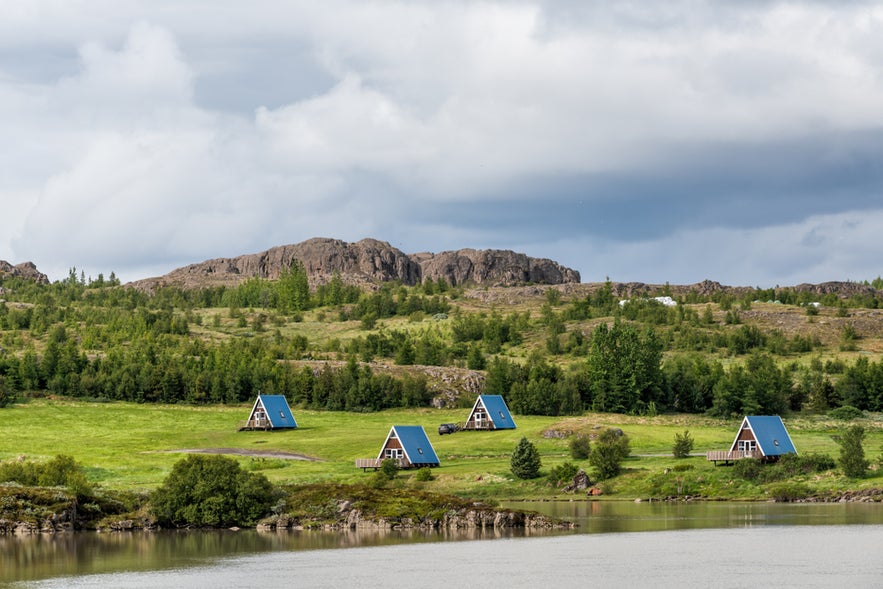 After a day of exploration, rest is key. The top accommodations in East Iceland offer a cozy and comfortable base for your Eastfjords adventure. You'll find everything from cozy village guesthouses to stylish boutique stays with fjord and mountain views.
After a day of exploration, rest is key. The top accommodations in East Iceland offer a cozy and comfortable base for your Eastfjords adventure. You'll find everything from cozy village guesthouses to stylish boutique stays with fjord and mountain views.
Here are some popular places to stay in the Eastfjords.
Hotel Breiddalsvik
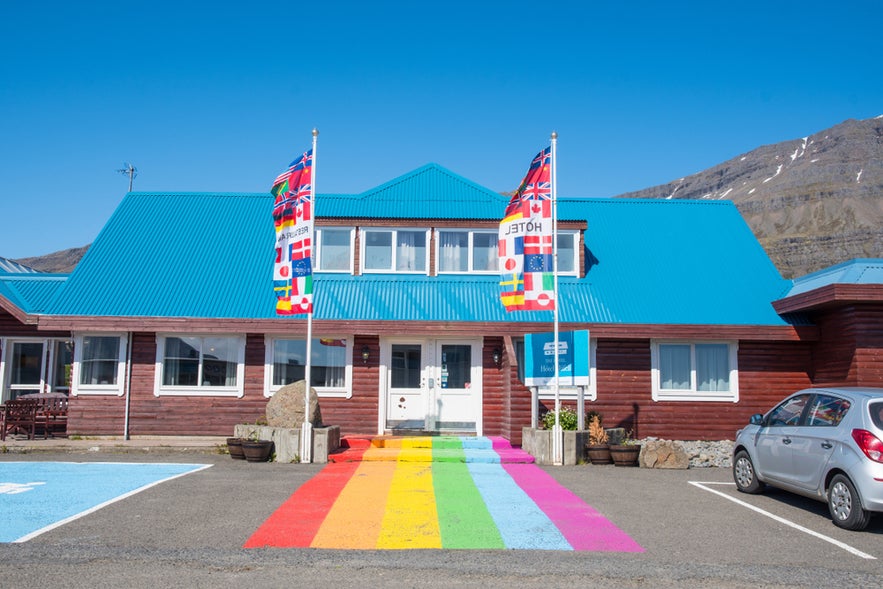 Hotel Breiddalsvik is a cozy, family-run hotel nestled between mountains and sea in the quiet village of Breiddalsvik. It offers comfortable rooms, a warm lounge with a fireplace, and a Finnish-style sauna, perfect for relaxing after exploring East Iceland’s wild landscapes. It’s ideally located along the Ring Road, making it a great base for visiting nearby waterfalls like Flogufoss and Beljandi.
Hotel Breiddalsvik is a cozy, family-run hotel nestled between mountains and sea in the quiet village of Breiddalsvik. It offers comfortable rooms, a warm lounge with a fireplace, and a Finnish-style sauna, perfect for relaxing after exploring East Iceland’s wild landscapes. It’s ideally located along the Ring Road, making it a great base for visiting nearby waterfalls like Flogufoss and Beljandi.
Guests can enjoy local cuisine at the on-site restaurant, which features fresh fish, Icelandic lamb, and seasonal ingredients. The hotel also offers helpful services like a tour desk, northern lights wake-up calls, and guided hikes. Whether you're chasing auroras or hiking scenic trails, Hotel Breiddalsvík offers a relaxing and authentic stay in the heart of the Eastfjords.
Fosshotel Eastfjords
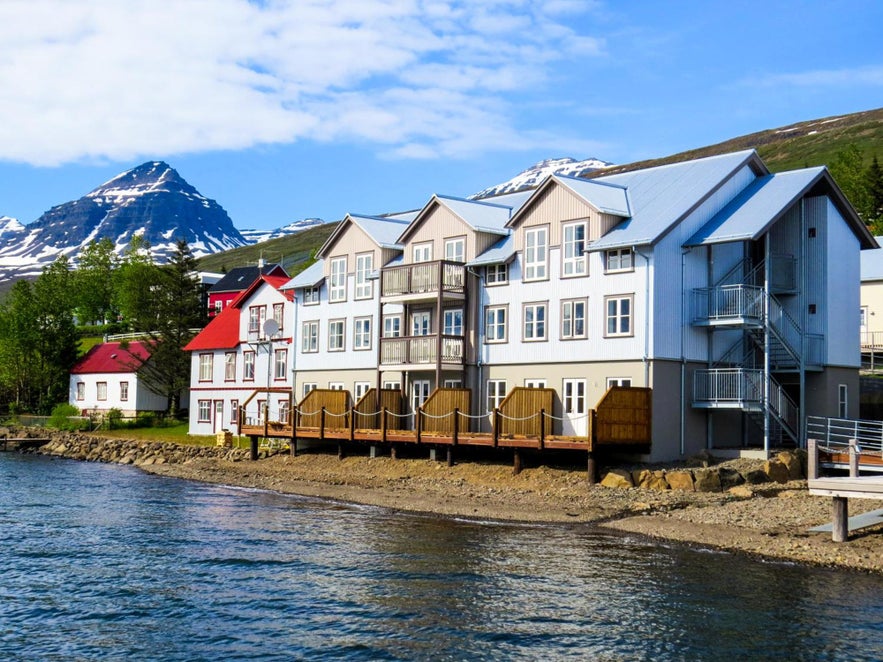 Fosshotel Eastfjords is set in a beautifully restored 1903 French hospital building in Faskrudsfjordur. This unique hotel blends historical character with modern comfort, offering bright, stylish rooms with views of the surrounding fjord and mountains. Guests can explore original architectural details and a small museum honoring the village's French fishing heritage.
Fosshotel Eastfjords is set in a beautifully restored 1903 French hospital building in Faskrudsfjordur. This unique hotel blends historical character with modern comfort, offering bright, stylish rooms with views of the surrounding fjord and mountains. Guests can explore original architectural details and a small museum honoring the village's French fishing heritage.
The waterfront restaurant, L’Abri, serves French-inspired dishes made with fresh Icelandic ingredients in a cozy, scenic setting. With its warm hospitality, peaceful location, and rich history, Fosshotel Eastfjords is an ideal base for travelers looking to relax, enjoy local culture, and explore the natural beauty of East Iceland.
Hotel Eyvindara
 Hotel Eyvindara is a quiet countryside retreat located just a few minutes from Egilsstadir, surrounded by woodlands and river views. It offers a mix of comfortable hotel rooms and private cottages, some with terraces and kitchenettes. The setting is ideal for travelers looking to relax in nature while staying close to town.
Hotel Eyvindara is a quiet countryside retreat located just a few minutes from Egilsstadir, surrounded by woodlands and river views. It offers a mix of comfortable hotel rooms and private cottages, some with terraces and kitchenettes. The setting is ideal for travelers looking to relax in nature while staying close to town.
Guests can unwind in outdoor hot tubs, enjoy drinks at the bar, or dine at the on-site restaurant serving seasonal Icelandic dishes. The friendly staff provide local tips and warm hospitality. With easy access to hiking trails, waterfalls, and Vok Baths, Hotel Eyvindara is a perfect base for exploring East Iceland.
Gistihusid Lake Hotel Egilsstadir
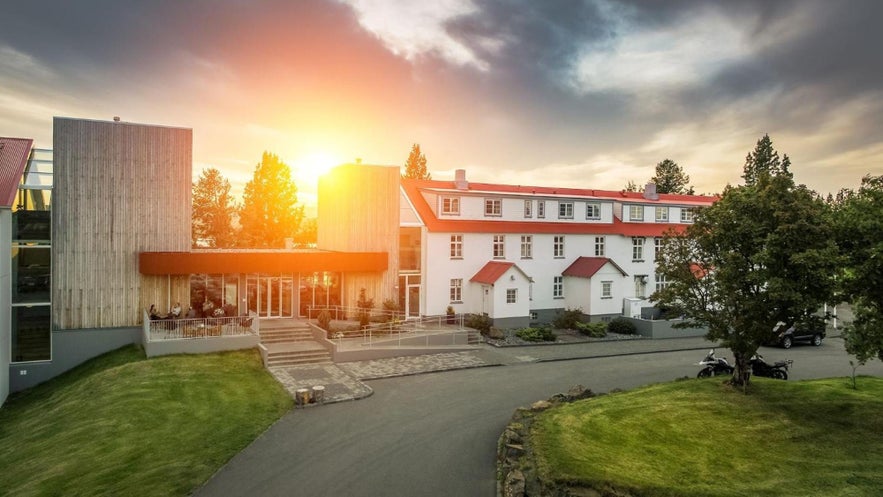 Gistihusid Lake Hotel Egilsstadir sits along the banks of Lake Lagarfljot, blending rustic charm with modern style and comfort. The hotel features a variety of cozy and elegant rooms, many with views of the lake or nearby mountains. It’s just minutes from Egilsstadir Airport, making it an ideal stop on any East Iceland itinerary.
Gistihusid Lake Hotel Egilsstadir sits along the banks of Lake Lagarfljot, blending rustic charm with modern style and comfort. The hotel features a variety of cozy and elegant rooms, many with views of the lake or nearby mountains. It’s just minutes from Egilsstadir Airport, making it an ideal stop on any East Iceland itinerary.
Guests can relax at the on-site spa, complete with a sauna, hot tub, and cold plunge overlooking the water. The Eldhusid restaurant serves fresh, locally sourced Icelandic dishes in a warm, welcoming setting. With peaceful surroundings, a full-service spa, and gourmet dining, this hotel offers a tranquil escape in the heart of the Eastfjords.
Frequently Asked Questions
Here are the frequently asked questions about visiting Iceland’s Eastfjords:
When is the best time to visit the East Fjords?
The best time to visit the Eastfjords depends on the experience you're seeking. Summer (June to August) offers long daylight hours, open mountain trails, wildlife sightings, and vibrant local festivals, perfect for hiking, road trips, and nature photography.
For fewer crowds and a more peaceful atmosphere, the shoulder seasons of May and September are ideal. You’ll enjoy quiet roads, beautiful autumn or spring colors, and a chance to see the northern lights on clear nights. Winter appeals to adventurous travelers drawn to snow-covered landscapes, cozy villages, and aurora chasing in near-total darkness.
Can I drive in the Eastfjords in winter?
Yes, you can drive in the Eastfjords during winter, but conditions can be challenging. Roads may be icy, snowy, or occasionally closed due to weather. It’s essential to have a sturdy 4WD vehicle equipped for winter driving. Always check current road conditions and weather updates before setting out to stay safe and prepared.
What should I pack when visiting the Eastfjords?
Pack versatile, layered clothing to adapt to rapidly changing weather, including warm base layers and a waterproof outer shell. Sturdy, waterproof boots are essential for hiking and exploring rugged terrain. Don’t forget binoculars to spot wildlife like puffins and reindeer, and a tripod if you plan to capture stunning aurora borealis or sweeping landscapes. Extras like a reusable water bottle, a hat, and gloves will keep you comfortable during outdoor adventures.
Where are the best places to see the northern lights in Eastfjords?
For the best northern lights viewing, seek out dark skies far from light pollution. Breiddalsvik and Borgarfjordur Eystri are popular spots known for clear, unobstructed views. You can also find incredible vantage points atop fjord peaks or along quiet coastal roads, where the aurora dances above stunning landscapes.
Is there mobile reception in the Eastfjords?
Most larger villages have good 4G, but expect limited or no coverage in secluded valleys and mountain roads.
Are guided tours available in the Eastfjords?
Absolutely! The Eastfjords offer a variety of guided tours to suit every interest. Choose from puffin-watching boat tours, glacier hikes near Egilsstadir, horseback riding adventures, and immersive cultural heritage experiences in Seydisfjordur. Whether you seek wildlife, nature, or local history, there’s a tour for you.
Final Thoughts
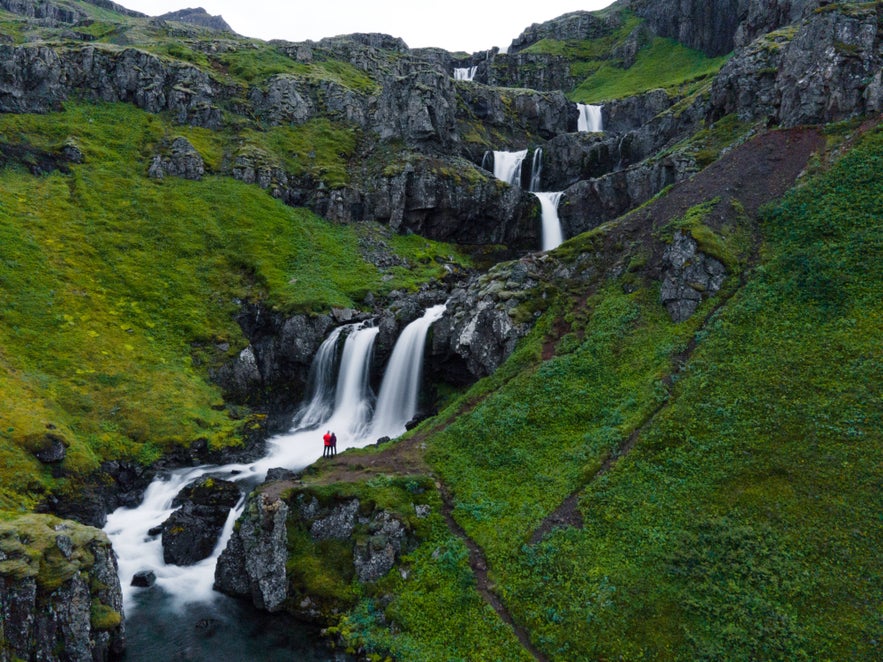 Iceland’s Eastfjords are a treasure trove of natural wonders, quiet charm, and wild beauty. Whether you're hiking through untamed valleys, watching puffins nest on seaside cliffs, or relaxing in a geothermal pool with a view of the mountains, this region delivers moments of peace and awe.
Iceland’s Eastfjords are a treasure trove of natural wonders, quiet charm, and wild beauty. Whether you're hiking through untamed valleys, watching puffins nest on seaside cliffs, or relaxing in a geothermal pool with a view of the mountains, this region delivers moments of peace and awe.
Take the road less traveled and make the Eastfjords a part of your Iceland itinerary.
Have you ever driven through Iceland’s remote Eastfjords? Which hidden hot springs or coastal villages are on your must-see list? Share your dream East Iceland itinerary or ask us anything in the comments below!



